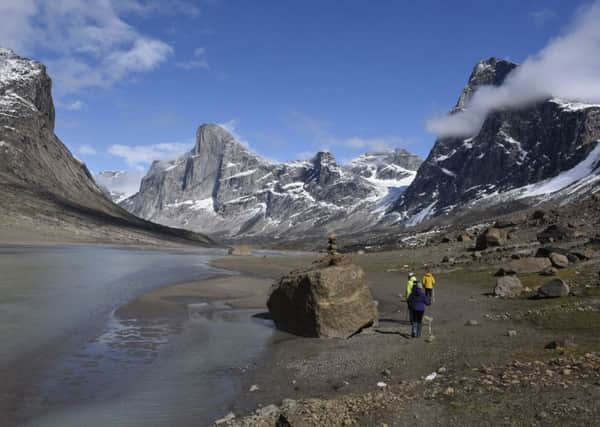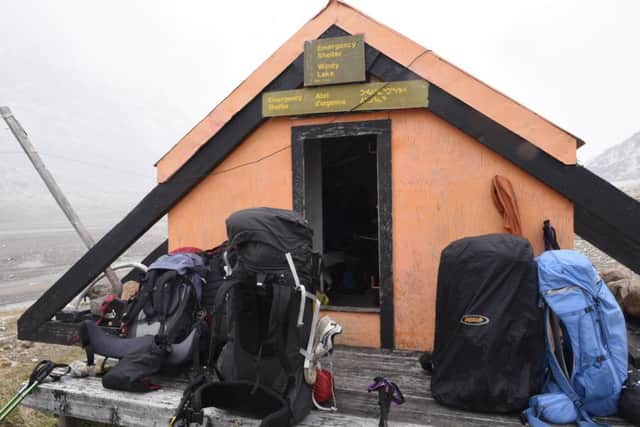Travel: Baffin Island, Canada


We had flown over oceans and mountains to join Black Feather’s Auyuittuq Getaway Hike, a nine-day, 70km journey along the Akshayuk Pass to Mount Thor and back on South Baffin Island in the Nunavut region of the Canadian Arctic. The main attraction? Thor’s must-see cliff face, the largest in the world at 1,500m.
As we approached the remote Inuit hamlet of Pangnirtung (Pang) in Auyuittuq, the weather cleared, which was fortunate, as landing there can be tricky and gales had delayed our arrival. Our guides, Coleen and Mark from Black Feather Wilderness Adventure Company, were waiting patiently for our small group of five of various nationalities, aged from 40 to 75. This trek suits adventurous souls, and no previous backpacking experience is required, although you need to be reasonably fit.
Advertisement
Hide AdAdvertisement
Hide AdPang is a small Inuit community of 1,350 inhabitants on Pangnirtung Fjord where small, brightly painted houses have replaced a nomadic lifestyle. The town is famous for its Inuit art and there’s a wonderful gallery that should not be missed.


At the Auyuittuq Lodge we repacked our bags, removing most of our personal stuff to make room for food rations, tents, cooking fuel and utensils. On a self-supported expedition our packs weighed around 60lbs, or 85lbs for the guides. We each hoped the meals we carried would be eaten first so our packs would become lighter.
Next stop was the Parks Canada office, where we stopped for registration and orientation and met Matthew Nakashuk from the resort management team.
“People come here and their main worry is seeing a polar bear while trekking,” he said. “The chances are that a polar bear is going to mind its own business. What people should be concerned about are river crossings.”
Walking poles are essential for crossing the tricky terrain and we used them to help us balance our weighty packs on slippy rocks.


Loaded on to a motorboat we were transported the 31km to the bottom of the fjord, where we met the fast-flowing and chilly Weasel River. We got close enough to the giant boulders lining the shore to throw over our packs, then followed and after a 2km scramble over rocks reached our first camp, Overlord. A sense of remoteness prevails up here, the weather changes frequently, and you are fully exposed to the elements.
It was the end of summer with 24 hours of daylight and a top temperature of 12C during the day, with night-time lows of perhaps 4C. However, it could snow at any time.
Our first dinner was spaghetti with dried meat and sauce – not bad considering it was cooked on an outback stove – and we turned in early, which is not easy at first in 24-hour daylight.
Advertisement
Hide AdAdvertisement
Hide AdOur second day took us 5km straight up the Weasel River Valley to around 214m, not that high, but the environment and heavy packs make the journey demanding.
In this spot, you feel remote, tiny and insignificant. You feel the power of nature – both its gentle and forceful sides. Sediment lay all around, glacier tongues tumbled over the mountaintops and a few spring flowers bloomed. There is little in the way of wildlife: some Canadian geese, perhaps an Arctic fox or hare.
Blue sky and sunshine greeted us at our next campsite, Sandcastle – a boulder-strewn meadow with deep soft moss and stunning valley views.
We made trips to the roaring Weasel River for water, which was cold but beautiful to drink. Dinner was rice, tortillas and a dodgy cheesecake – an interesting mix, created by outback MasterChefs Coleen and Marc. The food was generally pretty good, the ingredients bagged up in advance, making it easier to prepare at the camp.
Next morning we climbed on up the valley until we crossed into the Arctic Circle, where an Inuit inuksuk – a stone cairn traditionally used for navigation or to pinpoint camps or food caches – marked the spot. As the wind and rain picked up, we came across a massive landslide, and up-and-over being the only way, we clambered and scrambled to the top. Eventually we cleared the slide and searched in the wind, rain and cold for a spot to camp. With tents as hard to pin down as helium-filled balloons, this caused a few laughs, but we managed.
After a howling wind almost taking our tent away during the night and a snowfall of 30cm that slid down in chunks, we awoke to see Mount Thor for the first time.
It was foggy at first but then for a few hours the snow stopped and the sun came out to display the white-topped peak we had come to see. At first sight it was menacing and made me extra-conscious of our vulnerability in this Arctic wilderness, yet it was spectacular – the longest vertical drop in the world.
After a light lunch, we trekked nearer, the clear blue sky giving us amazing views of Thor’s sheer face and we spent the entire day walking as close to the base as we could get. The knowledge that very few people have walked here before is one of the things that makes this trip exceptional and we felt reduced to insignificance in the vast landscape.
Advertisement
Hide AdAdvertisement
Hide AdAfter marvelling at the view, we began our journey back to camp as the window of good weather shut instantaneously, and behind us the mighty mountain was gone. As the snow fell harder we retreated down the valley and over the landslide back to the river, making it to North Sandcastle camp, where we spent two nights snowed in. After two days it cleared enough for us to walk 4km back to South Sandcastle and our camp from the second night.
Our final morning had arrived and we loaded the remains of the food into our packs, along with all the rubbish, and walked the remaining stretch through small streams and rocky terrain taking in the immense landscape one last time.
Although it took planning and a lot of travelling to reach Pangnirtung, the spectacle of the surrounding scenery made it the experience of a lifetime.
Getting to Pangnirtung
Fly Air Canada from the UK to Toronto with an overnight at Toronto airport and an early start the next day on a one-hour flight to Ottawa (www.aircanada.com). Then take another two-and-a-half-hour flight with First Air to Iqaluit, and a one-hour jump to Pangnirtung (firstair.ca).
Auyuittuq Getaway Hike
Black Feather – The Wilderness Adventure Company (www.blackfeather.com, [email protected]) offers 10 days/nine nights adventure skill Level 1, C$4,095 (£2.265)
Pangnirtung, Nunavut, Black Feather is partnered with the Flight Centre (https://www.flightcentre.ca). Contact Jonathan Arden ([email protected]) for full access to Black Feather’s group rates with First Air, and to arrange international and domestic flights to Pangnirtung, travel insurance, and any necessary extra hotel accommodation.